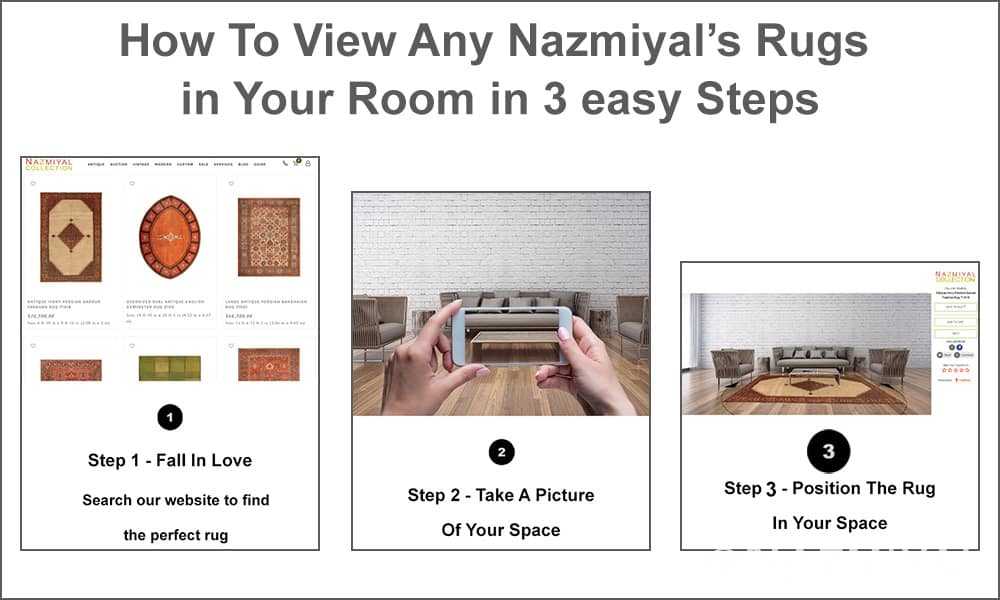Everything You Ever Wanted To Know About Area Rugs
What are “area rugs”?
“Area rugs” are floor coverings that are typically used to define a specific area within a room. They are often placed on top of existing flooring, such as hardwood, tile, or even carpet, to add warmth, comfort, and style to a space. Area rugs come in various shapes, sizes, colors, patterns, and materials to suit different design preferences and functional needs.
These rugs are versatile and can be used in different areas of a home, including living rooms, bedrooms, dining rooms, entryways, and hallways. They can serve multiple purposes, such as adding a decorative element, creating a focal point, protecting the underlying floor from wear and tear, providing cushioning, reducing noise, and defining separate areas within an open floor plan.
Area rugs can be made from natural fibers like wool, silk, jute, sisal, or cotton, or they can be crafted from synthetic materials such as nylon, polyester, or polypropylene. The choice of material depends on factors like durability, softness, ease of maintenance, and budget.
These rugs are available in various styles, ranging from traditional and oriental designs to modern and contemporary patterns. Some area rugs feature intricate patterns, while others may have solid colors or geometric shapes. The design options are vast, allowing individuals to find a rug that complements their existing decor or serves as a statement piece.
Overall, area rugs are an essential component of interior design, providing both functional and aesthetic benefits to enhance the look and feel of a room.
Creating beautiful interiors with area rugs
One of the quickest ways to make a huge impact in your room is incorporating area rugs (or by removing them).
View the below image to see just how different the interior designs look with and without area rugs:
Here are some pictures of incredible area rugs in the rooms where they live:

Picture Of Rooms With Area Rugs
Now see the same rooms without the area rugs:
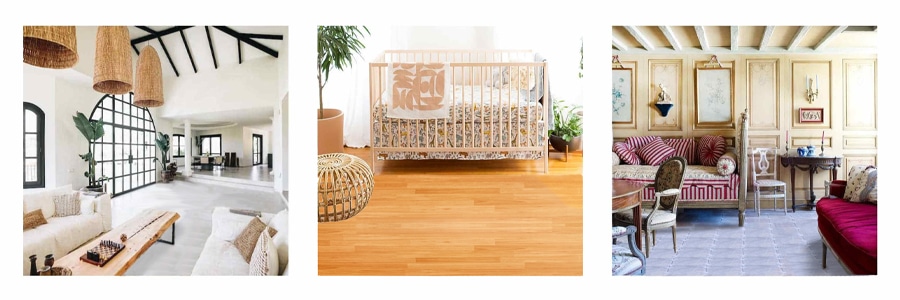
Picture Of The Same Rooms Without The Area Rugs
As you can see, without the rugs, the spaces lose warmth, energy, and some sense of purpose. If you’re shopping for an area rug, maybe there is a blank space like those in your life you are looking to fill.
An area rug is so named because it only takes up part of the room it is in. Consider the first photo in our trio above, where matching rugs define not just the sitting area, but another path to a door. Even an area that is otherwise just blank space can be given purpose with a rug. In other cases, rugs add color and vibrancy, like the nursery. Baby’s time in the room may not be as fun or stimulating without the warmth and rich pattern of the rug on the floor. A rug often also draws together furniture and adds to a sense of cohesion in a room. Without the rug in the third example do you think the couches look further apart? The absence of the rug makes the space feel cold and unfinished.
Rugs have been valued for centuries as works of art that can move and travel. Woven by artisans from precious threads and dyes, even modern rugs come with a story of where they were made. In cases of antique and vintage rugs, there are further stories of human history pressed into the fabric.
Maybe replacing a rug is why you are here. Or you might be looking for a rug to set the tone for a fresh adventure in design. Regardless of how large or small a rug you need, the Internet is full of options. Everyone must be guided by their own personal tastes and preferences when deciding on the best area rug for home or business. And yet the most important tip about shopping for rugs is to keep an open mind. A rug of a unique size, with unexpected color or pattern, could inspire new feelings about the room. Allowing yourself to be surprised will push you closer to the joy of finding the area rug you love that is worth the investment.
Whether you are shopping to refresh a space or achieve a new vision this guide will answer your basic questions about buying area rugs.
Area Rug Sizes FAQs
The size of an area rug is a main question for most people in the shopping process. Buying a rug of the perfect size saves effort and lets the rest of the design grow around it. In some cases, but not always, the size of the rug also informs the price.
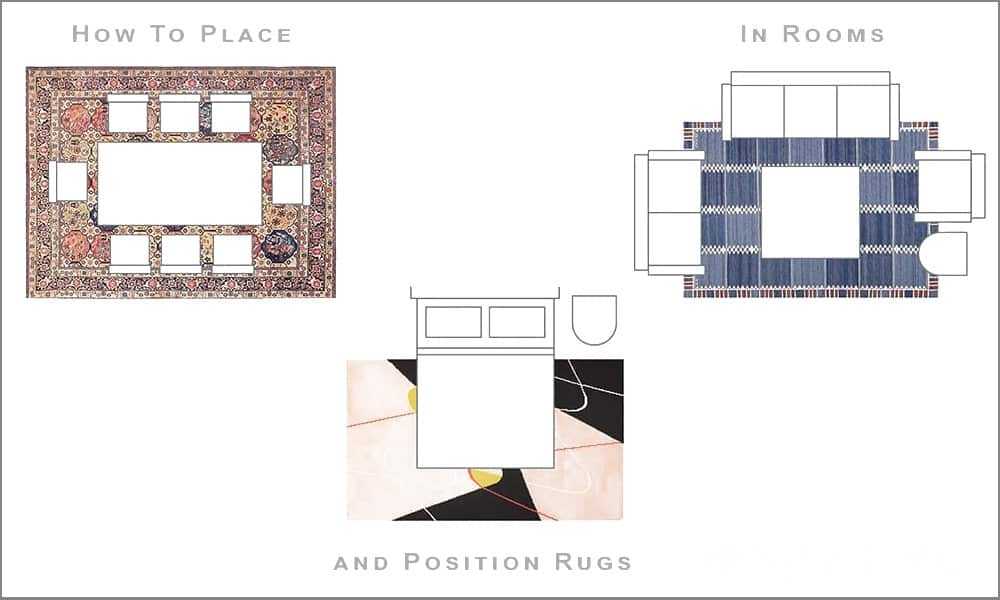
How To Position and Place Rugs in Rooms
We’ve seen some customers buy rugs larger than their room and have them sized down for an appropriate fit. Others buy a 6 x 9 “rug to frame the furniture in a 20 x 40” room. With area rugs, there are no hard and fast rules. What’s important is finding the rug that evokes the way you want to feel and want others to feel.
What Are the Standard Rug Sizes in Feet?
Small rugs are considered less than 5 feet, medium rugs are 5 to 8.5 feet, and large rugs are 9 feet and beyond. For a round rug, this is the measurement across the circle. Squares and rectangles come in all shapes and lengths/widths to fit most spaces.
What Are the Standard Rug Sizes in Metric?
Small rugs are considered 1.5 meter or less, medium rugs are 1.5 to 2.5 meters, and 3 meters or more is a large rug.
We recommend shopping by minimum and maximum size you could use in the space, not just for one size only. This will expose you to options that are smaller or larger than you considered. These could end up better fits for your needs.
Many rugs can be cut to order, so a large rug doesn’t have to be written off. A smaller rug than you might think could also provide the desired impact and functionality for your space. Don’t let rug size distract you too much as this is one of the first things people compromise on while shopping.
What Is The Most Popular Area Rug Size?
People tend to like large area rugs to define their living space. As a general rule, you want the rug to go two feet beyond where your furniture stops. Small rugs can also provide statement accents or protect underlying carpets in high traffic areas.
- Rug sizes for the living room are often 8 x 10 or 9 x 12, but square rugs and smaller rugs can also be used in combination. Common layouts include having the rug underneath all the furniture, or just underneath the front legs of the furniture. Some may orient a rug under just the coffee table. Click to view: Living room rugs
- Rug sizes for a bedroom are whatever looks nice underneath a queen or king size bed. The rug might take up all the space beneath the bed or just the bottom two-thirds. Some people also like smaller rugs next to the bed or in front of the dresser. Click to view: Bedroom rugs
- Rug sizes for the kitchen are often runners to take up a narrow space. Many antique carpets especially have the size and vibrance suited to a small space like a kitchen. Click to view: Rugs For The Kitchen
- Rug sizes for offices vary based on the layout. A rug underneath one desk or workstation should be large enough to contain the desk and any chairs in its area. For a rug that will take up most of an office, keeping it one to two feet shorter than the shortest wall will preserve a sense of balance. Click to view: Office rugs
- Rug sizes for hospitality spaces can be incredibly diverse, with a large commercial hotel franchise having completely different needs than a small historic boutique. Generally, the rugs in the rooms and in the common spaces will share similar designs and aesthetic to provide guests with a consistent experience. On the other hand, unique spaces like a lobby bar or in-suite sitting area can draw energy and a sense of place from distinctive rugs. Click to view: Hospitality Industry and Rugs For Hotels
Ultimately, it doesn’t matter what size others consider most popular or best. What matters is if you love the rug you end up with.
Where Can I Find a Rug Size Visualizer?
Forming an opinion about the kind of area rug you want is easier when you can visualize the rug in your space. That’s why we created our rug visualizer, to help you view any rug from our inventory in your room. You simply take a photo of the place you think the rug would go, and use the visualizer to align the image and get a sense of how it might look. Remember, try out a few that are questionable to challenge any assumptions. This will make it more likely you find a rug that can serve the long-term needs and goals for the room in question.
Area Rug Styles FAQs
People shopping for area rugs have lots of questions about design best practices:
- Should a rug be lighter or darker than the floor?
- Should a rug be lighter or darker than a couch?
- Should a rug be wider than a couch?
- What is the best rug color in the living room?
The answers to all these questions depend on personal taste, as well as the feelings you want the space to inspire. Ask yourself what you think the answer is and you are probably right. If you don’t know your own opinion right away, it’s probably just because you never thought about it before. Try out and compare a few options to see what you like. That’s where our rug visualizer above can come in handy to let you see a simulation of different rugs in your space.
When should you buy an area rug? Ideally, making the decision on the rug early informs the rest of the choices about a room, like fabrics and furniture. It is much easier to match those elements to a great rug. Though, it’s certainly not impossible to start with another piece for inspiration and find a rug to match. A new area rug can even bring fresh appeal to an existing design and color scheme without any other changes. Any time can be the right time to buy a rug, especially if your style has evolved.
What Is the Current Trend for Area Rugs?
Current area rug trends include geometric patterns, joyous energy, and colors in all hues. Rugs are an excellent way to make an old space new again, which many people crave at home and at work right now. Rugs give a room immediate personality and history, lending new energy to the people who walk on them. Let’s unpack current area rug trends and different schools/eras of design more in-depth. Current interior design trends include pared-back, neutral shades in warmer tones than eras of the past. Browns and golds are replacing cool grays as the preferred neutral for many designers.
Antique Area Rugs: Muted Colors, Rich History
Heirloom items like antique rugs come with a story to go along with their soft colors and textures. Those who buy these rugs don’t just continue the story but become part of it. This is very appealing to lots of customers in today’s market. Nostalgia and a sense of inclusion are driving emotions for many, and an antique rug can speak to both. We have the biggest collection of antique rugs in the world which you can shop by specific nations of origin, color families, or by shape.
Mid Century Modern Area Rugs: Simple, Vibrant Statements
Current culture is trending more toward putting joy at the center of life, and mid-century modern elements in interior design reflect that shift. However, no two of these rugs are exactly alike, and neither are the spaces they define, allowing each an individual appeal. Mid-century modern area rugs vary widely in style and pattern, from the broad strokes of Art Deco rugs in the 1920’s-40’s to more modern Scandinavian rugs from the 60’s onward. Rugs from each of these eras set different tones of elegance, motivation, focus, and flow. With a few vintage rugs on deck, you can even change the mood according to what is needed at the time.
Colorful Modern Area Rugs: Abstract Future-Focused Flexibility
Modern area rugs are still the work of exceptional crafters and artisans around the world. These designs are simple yet bold, allowing one space to be used for many purposes. For instance, if a living room needs to double as an office, a modern rug can readily provide an abstract backdrop for work and relaxation time. This aligns with current home and office design trends as the way we live and work in our spaces continues to change.
As far as rug materials to avoid, everything is a matter of personal preference when it comes to rugs. All our rugs are made of natural fibers like wool, silk, cotton, and sisal (agave fiber). Often several materials will be used to complete a rug. Rugs are woven tapestries and works of art, whether their pattern traces ancient, familiar shapes or a one-of-a-kind vision from an incredible artist.
What Color Is Best for Area Rugs?
Your own personal beliefs about a color and experiences with it have the biggest impact on the colors you like. For example, in Western culture white symbolizes innocence, while in Eastern cultures it is a color of mourning. That means white would not be a color of choice for babies in the East, regardless of whether it makes the parents feel serene.
In addition to personal preference, the furnishings and colors within the space also inform what color rug to choose. To get an easy handle on all your options, you can use a color wheel like the one pictured below. Say your room already has a blue sofa. The teal and light purple shades to either side of blue are colors in the same family, so a rug including those shades would coordinate well. Or, you can go across the color wheel to blue’s complimentary color, orange, and explore that color family for a pleasing pop of contrast. Maybe you decide to take a right turn and go with blue and red as two primary colors. Really, it’s up to you and your taste.
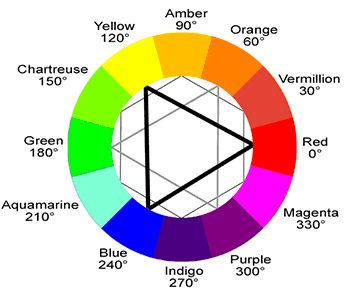
Color Wheel
The higher half of the light spectrum are warm colors: red, orange, and yellow. These make up the top of the rainbow and historically evoke feelings like warmth and power. Orange and yellow are sometimes seen as risky colors.
The lower half of the rainbow are the cool colors: green, blue, indigo, and violet. These round out the spectrum and are usually said to inspire stability, tranquility, and calm.
White and black are not colors, they are shades including every other color. But they also come with their own associations and significance. Their impacts in a space can be as neutrals or to provide contrast.
Overall, it’s believed that the impacts of color psychology are somewhat temporary. Yes, blue might make you feel calm and red might get you fired up, but only briefly. After you have been in a room for a little while, the events which happen inside it and the people around you influence your experience far more than the colors of the rug or other interiors. With that said, a great rug provides a backdrop for high quality moments and memories.
Area Rug Quality FAQs
How Can You Tell if a Rug is Good Quality?
One thing any high end rug dealer considers incredibly important is allowing you to see the rug in your space before a purchase. This lets you know if it’s truly the best quality fit for your needs. Here are some of the rug elements to examine when you see a rug and inspect it for purchase:
- Texture: How does the fabric of the rug feel? Does it invite the sense of comfort you want the room to carry?
- Edging: Is the stitching intact and good quality? Does the rug have fringe, tassels, or other edging, and do you like it?
- Strength: The rug’s foundation are the warp threads which are strung vertically on the loom for weaving. The rug is made by weaving or knotting colored threads between the warp threads. Many high-quality rugs are made with warp threads of more than one ply to avoid pilling, knotting, and snagging.
- Wear and Tear: Especially in the case of an antique rug, wear and tear is to be desired to a small extent. Part of the inherent value and appeal of these rugs is that they have stood the test of time and the passage of generations before. The sheen of wear on the rug, also known as the patina, adds to the beauty of each piece and reveals the story of where it has been previously. In the case of vintage and modern carpets which have existed 100 years or less, a high-quality carpet should look clean and not show a patina.
All these elements of the rug reveal its quality and how well it stands or will stand the test of time.
What Type of Rug Is Most Comfortable?
Some people prefer the flat weave and smoothness of cotton, while others like the texture and warmth of wool. Silk in a rug is usually combined with materials like wool to lend more comfort and unique textures. The same is true for sisal, which can be blended with other fabrics or woven into a rug by itself. Any rug can be comfortable!
What Impacts the Cost of a Rug?
The cost of a newly-made modern rug is determined by its size. Most quality rugs that are newly made will start at around $80 per square foot. That means a 9 x 12 rug in the $8,600 range. In high end uses it’s not uncommon for rugs to cost tens or even hundreds of thousands of dollars. When you consider that over 6,000 hours can easily go into hand weaving a rug, the cost or price of the rug gains some perspective. Assuming a single weaver works 40 hours a week, that could be three years of work!
The amount of time that goes into hand weaving a rug today illustrates the enduring nature of the value of antique rugs as well. If this takes a long time today, imagine how long it took in ancient and Victorian times. The cost of an antique rug is determined by many factors other than size, including the intrinsic value of the rug itself. The older the piece is, the more value it inherently has. Its origins, state of preservation, and other elements also play a role in the price of an antique or vintage area rug.
What Brand of Rug Is Best?
Some might argue the best brand of rug is something like those made by iconic artists such as Pablo Picasso or Paul Klee. These aren’t really rug “brands” so much as works of art designed or inspired by some of the best artists of modern times. But if you’re not into art rugs, you might prefer carpets from certain areas of the world or made with certain fibers. There is no one brand of rug that is best, or even really one style.
Shop Our Collection of High End Area Rugs
With our massive selection of antique and modern rugs, there’s bound to be some works of art among our collection that can fit your space. We invite you to browse our selection of fine rugs and decorative carpets according to color, size, shape, style, or whatever other criteria have captured your imagination.
Area Rugs and Carpets – Utility, Brilliance, Societal Impacts on the Fabric of History
There can be little doubt about the fact that area rugs of all types have always served as more than just everyday functional workhorses and decorative embellishments. Reaching back to the very origins of weaving itself, it is clear that rugs have had the ability to reshape everything from nomadic lifestyles to civilization at large.
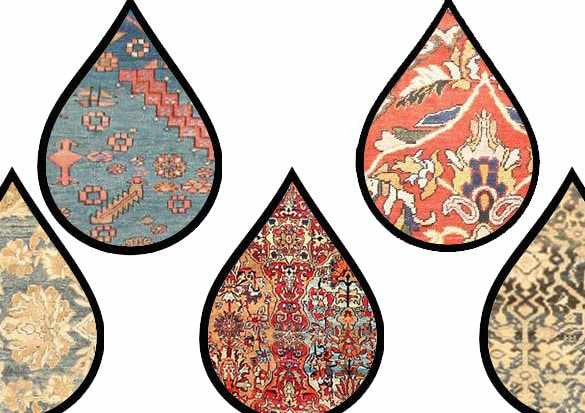
Rugs Rugs and More Rugs – Its Raining Rugs !!!
Rugs not only meet some of the most basic human needs within the home, they have long contributed to the evolution of society as it has come to be known.
Area Rugs as Transformative Expression
It really does bear repeating that area rugs have long reached well beyond the utilitarian realm to facilitate much more expansive ends. From the dramatic impact of weaving’s genesis on nomadic peoples to eventual nourishment of entire segments of civilization, the emergence of rugs, on a large scale, is a noteworthy historical occurrence. Even the most remote village could garner plaudits and attract merchants from all corners of the globe by developing a strong rug weaving tradition. Trade routes stretching from Asia to Europe would serve as conduits for these sought after textile art creations. In short order, rug weaving evolved into a real art form and made its way into every strata of society, from the modest all the way up to the royal.
Also of note is the fact that rug making served as an invaluable mode of expression and consciousness for their creators, the majority of whom were women rug weavers. This was true even in the male dominated patriarchal world in which they lived. Rugs represented perhaps the only form of free female expression and women’s liberation in an era otherwise devoid of such outlets.

Women Weaving Rugs Together
Across the ancient Oriental world, area rugs played a substantial role in religious practices. Whether those be the prayer rugs such as the Persian and Turkish rugs favored by adherents of Islam to the Khotan rugs used by monks rooted in the practice of Buddhism. Christian believers also placed great importance on antique rugs, as they have always been widely used in Protestant houses of worship and presented ceremoniously to leading officials in the church.
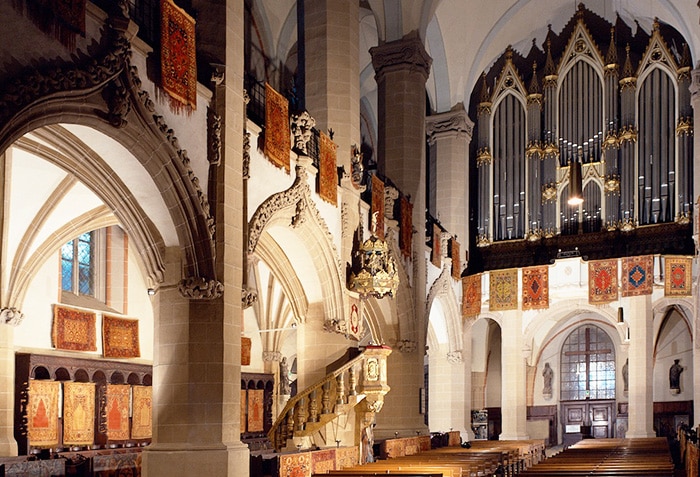
Early Rugs At Black Church in Brasov – South Eastern Transylvania Romania
The world’s love affair with finely woven rugs has endured for centuries, but has also gained new steam in the past century. Rugs can now be found in the worlds of fine art as well as high fashion and interior design. Vintage mid century modern rugs have gained the admiration of interior design professionals everywhere, and they are also coveted by discriminating rug collectors the world over. It is indisputable that vintage and antique rugs are interwoven in just about everyone’s daily existence and are properly considered part of a broader lifestyle. Rugs have contributed greatly to the development of innovative design and unorthodox thinking.
Fascinating Origins and Culture of Area Rugs
When it comes to the history of woven arts, and area rugs 1949 is properly considered to be a watershed year. This is when a Russian archaeologist by the name of Sergei Rudenko was scouring the Pazyryk Valley in Siberia, ultimately leading to the discovery of the tomb of a true Prince of Scythia. Within the tomb was an array of treasure that was undisturbed for more than 2500 years. A number of intriguing items were found therein, including devotional and decorative figures, saddles of cloth, cannabis seeds and inhalation paraphernalia, a large burial chariot and tattooed mummies, all of which offered a fascinating glimpse into the lives of Pazyryk’s nomads. However, this was not all that Rudenko revealed, as there was also an area rug.

Mummy of the Ukok Ice Princess From Pazyryk
The rug found in the tomb had been frozen for centuries, keeping it incredibly well preserved. It is in fact this Pazyryk pile rug is the oldest rug known to man. Its incredible state of preservation and unrivaled distinctiveness has provided no limit of excitement to art historians, textile specialists and carpet weavers of all types. The story of this rug serves to show how crucial it and others like it have always been even to the earliest civilizations.
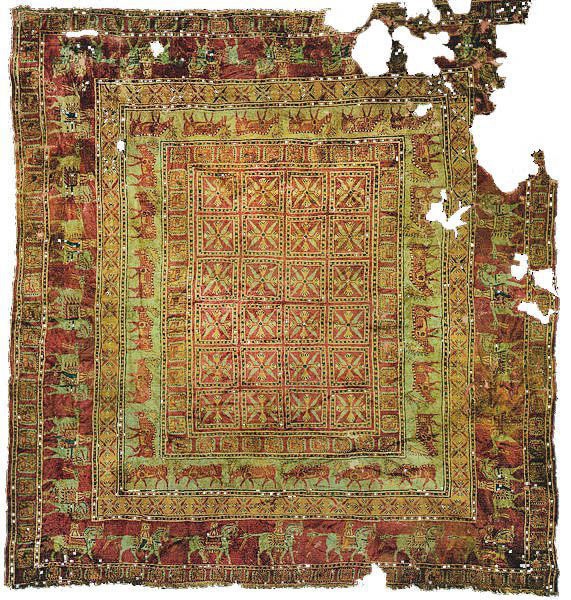
Image Of The Pile Pazyryk Rug – The Oldest Rug In The World
It is know understood that the Pazyryk carpet can be dated to roughly 400 B.C., a time period that is contemporaneous with the earliest discovered written mention of Persian rugs. Textiles of this sort were first discussed by Xenophon of Greece in the work Anabasis which dates to about 370 BC. In the 3rd chapter of the 7th book, a reference is made to Timasion having presented an especially worthy person with a silver bowl and a “carpet worth ten minas.” The area rug was discussed as being a valuable luxury item meant to be presented in the course of diplomacy. Though it remains unclear whether the rug at issue was flat woven kilim or one characterized by wool pile, or indeed whether embroidery or other techniques were used in its production, it is certain that the initial mention of Persian rugs occurs firmly in a context of status and privilege.
By the early part of the 16th century, area rugs of Persian origin assumed a role far more expansive than that of fancy items used to navigate diplomatic minefields or of utility items for nomads. Rather, they were transformed into a vital tool of statecraft by Shah Abbas. This happened when he launched an initiative to restructure the economy of his region by drawing merchants from Europe to visit. A key component of this was the modernization of textile production and facilitation of exports to the West of pile type rugs.
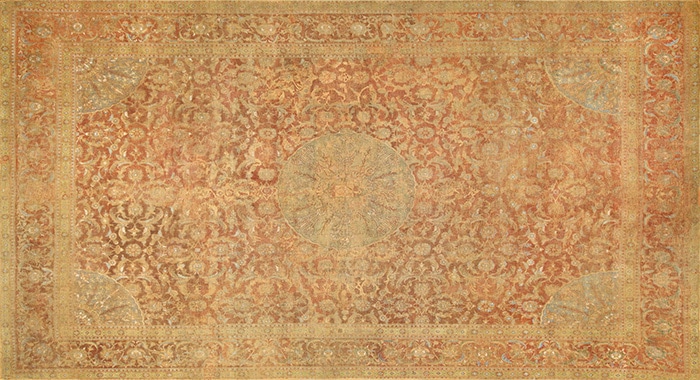
Antique 16th Century Cairene Rug
The Persian style of area rugs, whether hailing from Tabriz, Khorassan, Isfahan or Kerman, have long been known for high quality wool, goat and camel hair, cotton and silk, with each fiber type chosen for specific reasons and uses. Natural carpet dyes have been the standard of excellence characteristic of these rugs, and still today they are mostly made from animal and plant extracts. Because Persian rugs were clearly the product of a great deal of creativity and craftsmanship, it is not surprising that they became beloved the world over. Further, because religion was such a pillar of society in this part of the globe, it inevitably found expression in weaving, with distinctive prayer rugs soon taking center stage.
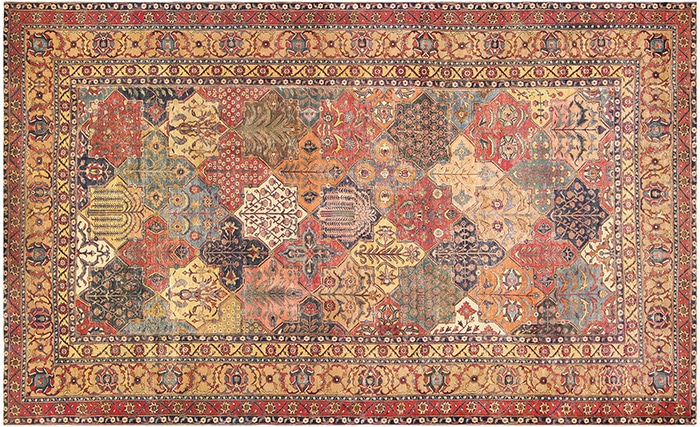
17th Century Persian Khorassan Rug
It is now the case that those who own antique or vintage / retro rugs are thought to have attained a particular level of societal status indicative of a very appealing lifestyle. Area rugs of this sort are symbols of discerning taste as well as impressive financial status, as fine rug weaving tend to come at a price. The truth is, though, that shopping for area rugs in this realm is money well spent. Antique rugs are timeless in their beauty, are extremely durable and fit well in a range of decorative styles, whether traditional, mid-century modern and more. Even minimalist interior design spaces can benefit from the anchoring abilities of a fine Persian or antique rug.
More About Rugs During The 20th Century
Early 20th century modernist design marked a real shift from the tastes and traditions of the Victorian age. Moving away from strict social strata and class division, the modern era put the spotlight on the effectiveness of simple lines, the beauty of geometry and the impressive impact that the deliberate use of color can have. Adherents of this movement engaged in daring experiments with pattern, shape and texture in a number of interesting ways.

20th Century Silk and Wool Fine Persian Nain Rug #60029
Excess and intricacy were substituted with a novel way of viewing the world. However, even in the midst of this sort of design sea change, traditional rugs continued to hold their place of importance. It seems counter intuitive, but despite changing tastes in almost every other aspect of design, antique area rugs retained their ability to provide essential grounding to rooms of all types. Whether rendered in a folk art style or an abstract geometric, there is a rug to suit every space conceivable.
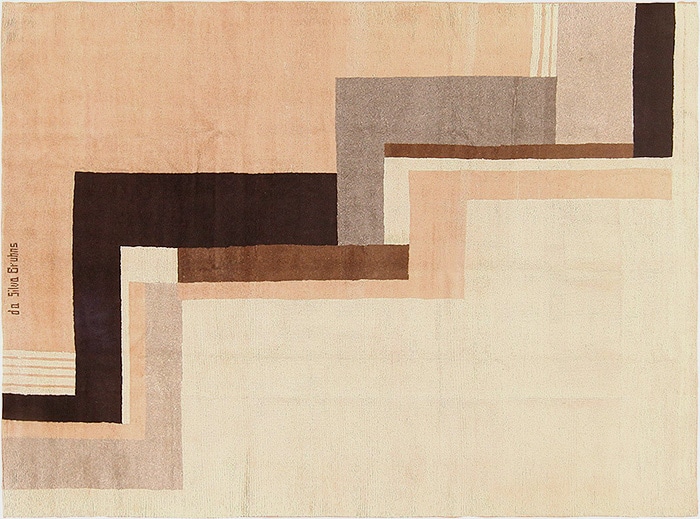
Early 20th Century French Art Deco Rug By De Silva
An impressive aspect of antique and vintage area rugs is their status as environmentally friendly art. Their painstaking creation already occurred and therefore they do not leave a new carbon footprint.
The use of natural dyes and textiles makes carpets of this type something that transcends time, space and societal preferences. They represent a firm nod to quality and tradition in an age that is all too often overrun with mass produced goods of inferior quality.
Antique Carpets and Vintage Area Rugs from Scandinavia Make A Splash
Swedish rugs in particular, but Scandinavian carpets generally are among the most significant categories of coveted vintage mid century textile art. Connoisseurs from all over the world appreciate the vivid colors and impressive weaving styles used in Scandinavian rugs. Further, they work brilliantly with a range of contemporary interior design styles. Their interpretation of regional landscapes, histories and ways of thinking are universally appealing, with nature always taking center stage, albeit in a more symbolic way than in the past.

Vintage Swedish Marta Maas Rug
At the heart of Scandinavian rug making is an overarching dream of equality in society. The fundamental idea is that everyone in society, not just the powerful and wealthy, should have the ability to obtain a visually pleasing and functional interior space. As such, incorporate beauty, utility and affordability in a remarkable way. Perhaps the most influential doyenne of this world of rug making was Marta Maas Fjetterstrom, who founded her own firm in 1919. Following her passing in 1942, the company’s direction was taken over by Barbro Nilsson.
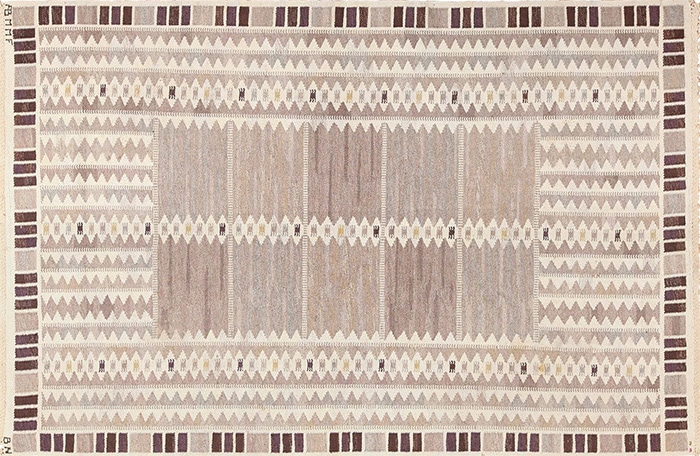
Vintage Salerno Gray Scandinavian Rug By Barbro Nilsson
Some other key names in 20th century Swedish rug making include Marin Hemmingson, Ingrid Dessau, Brita Grahn, Sigvard Bernadotte, Viola Grasten and Edna Martin. Each and every one of these innovators brought a unique thread to the overall history of Scandinavian design and weaving, an art form that continues to constantly attract more and more devotees. Contemporary design mavens adore the shapes, patterns and complementary coloring of these rugs, as well as their themes that are often drawn from regional folk tales and folk lore.
Moroccan Rugs Impact The Design World
When it comes to the most beloved vintage rug styles, few compare to those that hail from Morocco. Their originality and charm are unrivaled, as they are frequently festooned with tribal figures and patterns indicative of North African traditions. These beautiful rugs are storytellers in and of themselves, with symbolism taking the place of words. The creation of every part of a Moroccan rug is deliberate, with meaning woven throughout every inch. Omens and blessings are contained in these styles, providing an opportunity for women rug weavers to express themselves to the world.
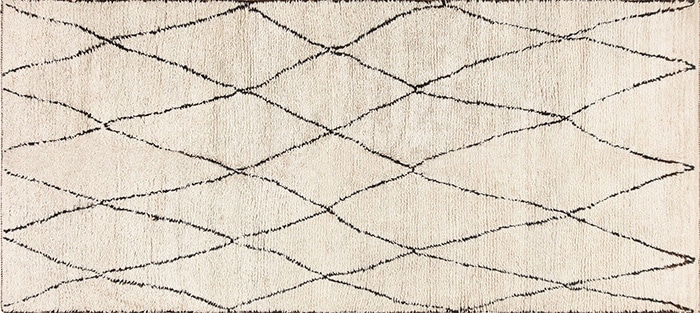
Vintage Moroccan Beni Ourain Rug
Leaders of the Modernist movement during the middle of the 20th century were particularly fond of Moroccan examples of rug making artistry, using them often in the spaces they created. While there are different types of Moroccan rugs, the Moroccan Beni Ourain rugs, specifically, were especially prized, perhaps because of the way in which they stand apart from other types of Moroccan Berber carpets. These Morocco made rugs are mostly dichromatic, made of beige fields with apparently randomized patterns rendered in charcoal and brown hues. Their shaggy rug piles are delightful underfoot. Copies of this style are produced in large numbers by factories nowadays, because the demand for them is so great. Rugs of this sort are seen as having greatly impacted designers including Vladimir Boberman and Ivan Da Silva. Some of the most evocative interior spaces of the 30’s and 40’s were designed by Frances Elkins, with these rugs playing a crucial role.
Rugs in the Arts and Crafts Tradition
Toward the end of the 19th century, taste makers in England had grown weary of mass produced items that were lagging in quality. In addition, tastes began to shift away from gaudy, ornate Victorian trimmings. Reform was in the air, and this extended to the way society would start thinking about the world and the things made in it.
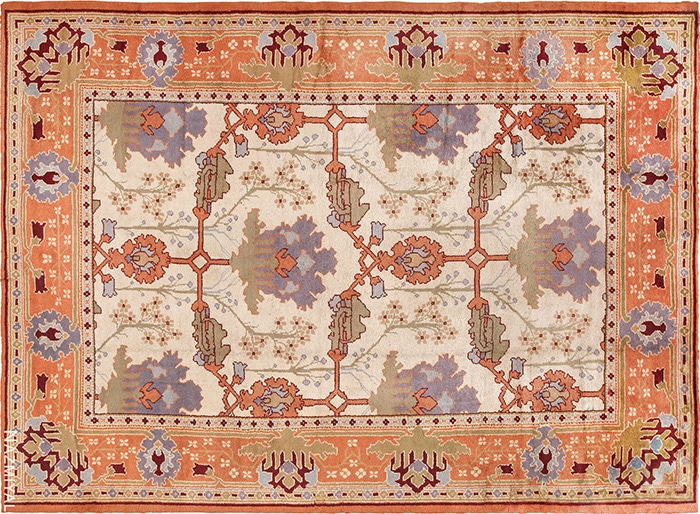
Gavin Morton Designed Arts and Crafts Rug
The realm of rug making was not immune to these changes, something evidenced by the emergence of the Arts and Crafts school of thought. William Morris, Gavin Morton and Charles Voysey brought an entirely new take to the naturalistic themes of earlier carpets. Rather than using intricate detailed botanical forms of the past, these designers gravitated toward more geometric displays that were more tribal, larger scale and open in feel.
Traditional blue and reds from Persian schools were replaced by earthier colors more likely to be found in a European garden. Pastel shades also played a role in the patterning of these area rugs, allowing them to lend an air of peacefulness to the interiors they adorned. Woven with high-quality wool and time tested methods, these area rugs remained loyal to the techniques and traditions of rug making across the centuries, yet they also brought a new spin all their own.
Area Rugs as Fashion Statements
In recent years, the themes and standards of antique rug creation have transitioned successfully into the world of fashion. This trend extends far beyond the “one off” creations of a home seamstress, with vintage rug themes having made their way onto runways and closets of taste makers everywhere. The timeless nature of these patterns and textiles is something that fashion mavens simply cannot ignore. The natural dyes, vivid jewel tone colors, impressive patterning and high degree of craftsmanship have broad appeal, and their popularity in the fashion world should really come as no surprise.
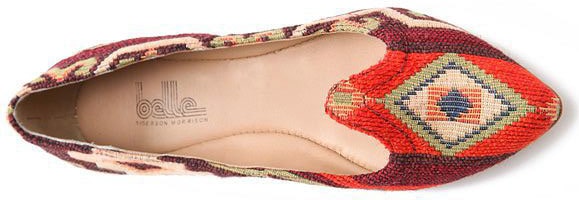
Belle By Sigerson – Kilim Show fashion
Some of the best-known names in modern fashion have taken notice of the rug making art form, putting it to use in their collections. Burberry, for instance, used carpet influenced fabrics to create a series of capes for its 2014 winter line. Kilim inspired bags also took the fashion world by storm, gaining massive popularity among both men and women shoppers. This is a true testament to the timeless qualities embodied in antique rugs.
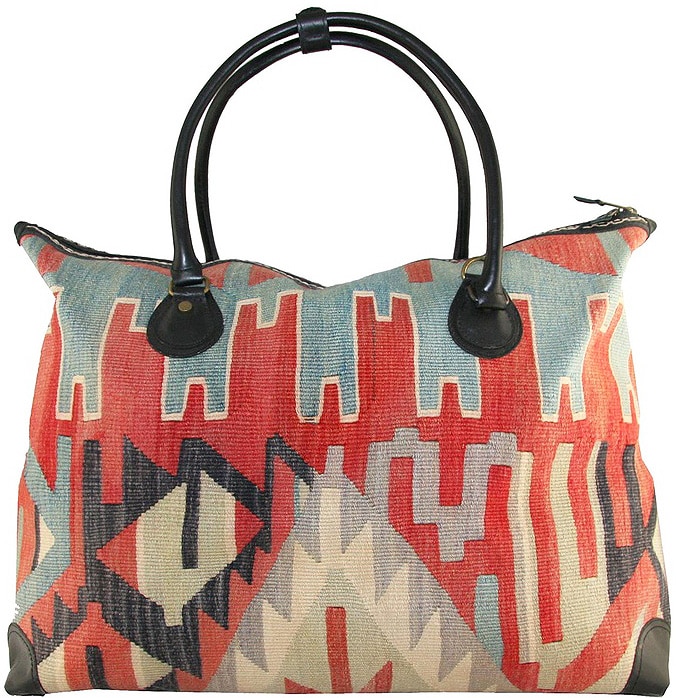
Boho Kilim Bag Fashion
Further, the 2014-15 collections of Dolce & Gabbana utilized French carpet patterns and themes to create a truly stunning line reminiscent of Savonnerie and Aubusson rugs. Embroidery, baroque florals and high quality textiles made this line a real standout in the fashion world during that period.
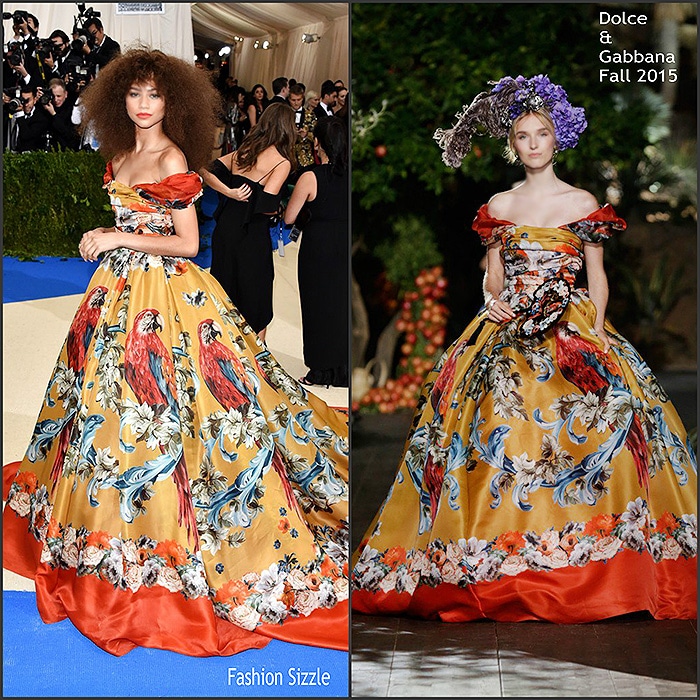
French Carpet Inspired Dolce & Gabbana Dress
Fashionistas with a more bohemian vibe can also take advantage of rug making traditions when it comes to what they wear. Kilim rug patterns, again, play a substantial role in this fashion trend, which has flourished from the 1970’s onward. Tribal patterns from India, Africa and elsewhere are frequently used in the creation of coats, dresses, ponchos, bags and more, appealing to free-wheeling, artistic individuals everywhere.
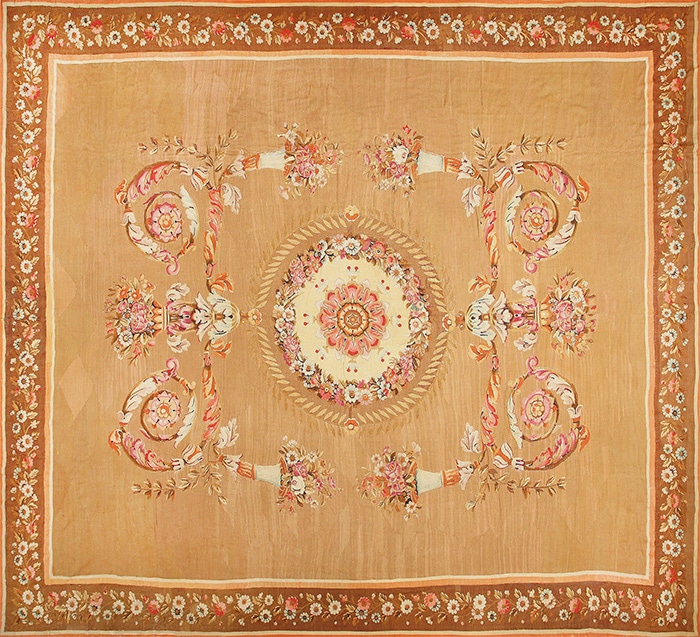
Antique French Aubusson Carpet
The Overarching Power of Vintage Rugs and Area Antique Carpets
It is impossible to dispute the power of antique rugs to bring a sense of grounding, warmth, vibrancy and interest to any interior space. Area rugs serve to establish conversation spaces for loved ones, create personal refuges for families and bring light and life to the home.
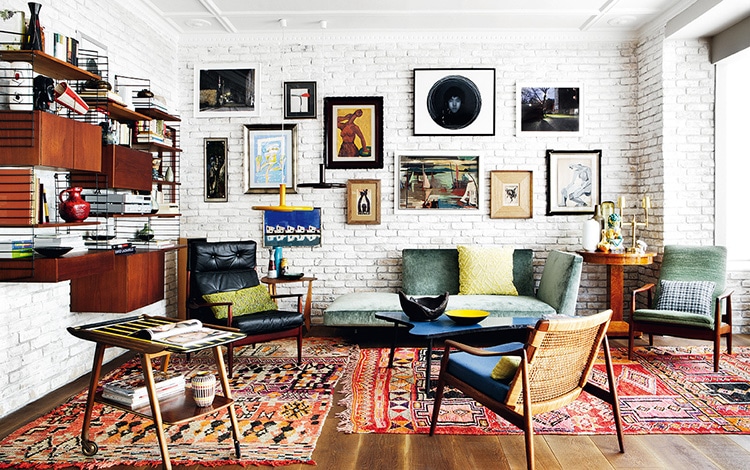
The Quintessential Boho Chic Decor With Vintage Moroccan Rugs
Vintage Persian rugs, in addition to other rug types, fit seamlessly into a dizzying array of design styles, including Mid-Century Modern, Bohemian, traditional, Victorian, Scandinavian and even Regency. Even an antique area rug that dates back centuries has relevance and of-the-moment appeal. There truly is no end in sight to the popularity, functionality and desirability of antique and vintage rugs.
This rug blog about the rug trends of 2020 was published by Nazmiyal Antique Rug Gallery in NYC.

